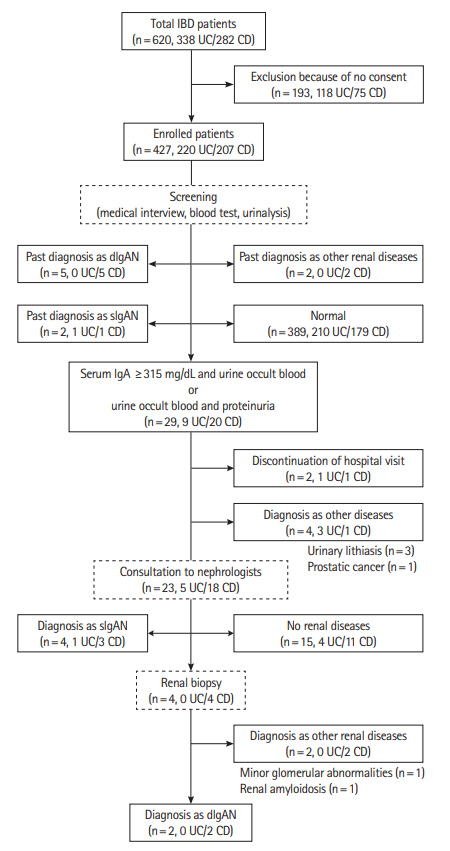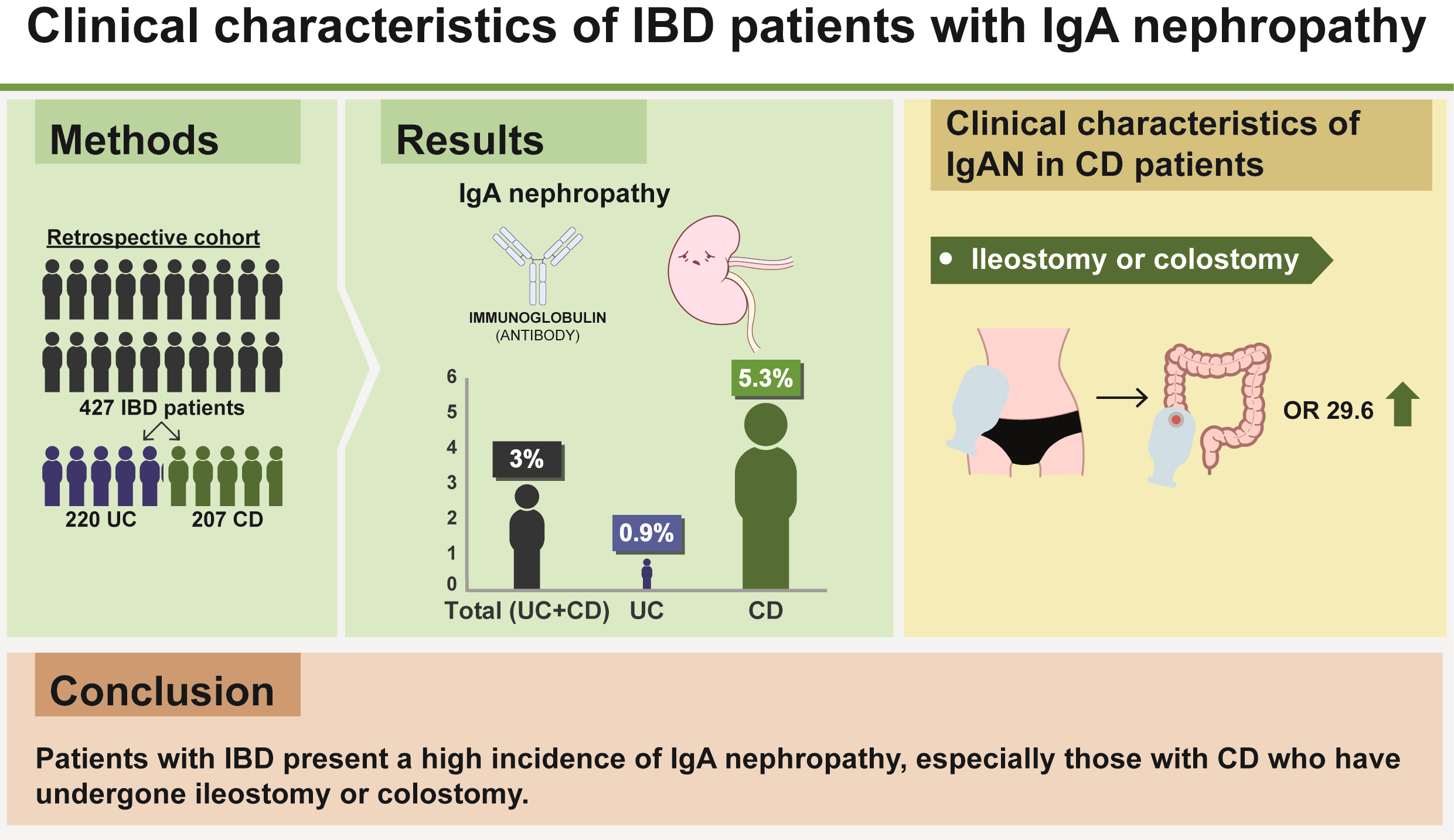 |
 |
- Search
| Intest Res > Volume 19(4); 2021 > Article |
|
Abstract
Background/Aims
Methods
Results
ADDITIONAL INFORMATION
Funding Source
The authors received no financial support for the research, authorship, and/or publication of this article.
Author Contribution
Conceptualization: Hayashi R, Ueno Y, Tanaka S, Sasaki K, Chayama K. Data curation: Hayashi R, Onishi K, Takasago T, Wakai M, Naito T. Formal analysis: Hayashi R. Investigation: Hayashi R, Ueno Y, Tanaka S, Onishi K, Takasago T, Wakai M, Naito T, Sasaki K, Doi S, Masaki T. Methodology: Hayashi R, Ueno Y, Tanaka S, Sasaki K, Masaki T, Chayama K. Project administration: Ueno Y, Tanaka S, Masaki T, Chayama K. Resources: Hayashi R, Ueno Y, Tanaka S, Onishi K, Takasago T, Wakai M, Naito T, Sasaki K, Doi S, Masaki T. Supervision: Ueno Y, Tanaka S, Masaki T, Chayama K. Validation: Ueno Y. Visualization: Hayashi R, Ueno Y, Tanaka S. Writing - original draft: Hayashi R, Ueno Y. Writing - review & editing: all authors. Approval of final manuscript: all authors.
Fig. 1.

Table 1.
Table 2.
| Result | UC (n = 220) | CD (n = 207) | P-valuea |
|---|---|---|---|
| Blood exam | |||
| IgA (mg/dL) | 238.7 ± 98.4 | 313.5 ± 137.2 | < 0.001 |
| Cr (mg/dL) | 0.7 ± 0.2 | 1.1 ± 3.6 | NS |
| CRP (mg/dL) | 0.3 ± 1.6 | 0.5 ± 1.1 | NS |
| Urinary exam | |||
| Occult blood | 41 (18.6) | 33 (15.9) | NS |
| Proteinuria | 7 (3.2) | 22 (10.6) | < 0.010 |
| IgA nephropathy | |||
| sIgAN | 2 (0.9) | 4 (1.9) | NS |
| dIgAN | 0 | 7 (3.3) | < 0.010 |
| Total (sIgAN+dIgAN) | 2 (0.9) | 11 (5.3) | < 0.010 |
Table 3.
| Variable | Without IgAN (n = 412) | With sIgAN (n = 6) | With dIgAN (n = 7) | P-valuea |
|---|---|---|---|---|
| Male sex | 262 (64) | 6 (100) | 5 (71) | NS |
| Age (yr) | 45.5±14.8 | 51.0±15.7 | 44.7±13.2 | NS |
| Diagnoses | < 0.010 | |||
| UC | 217 (53) | 2 (33) | 0 | |
| CD | 195 (47) | 4 (67) | 7 (100) | |
| Disease duration (yr) | 13.0 ± 9.9 | 22.2 ± 10.7 | 23.0 ± 8.5 | < 0.010 |
| Blood exam | ||||
| IgA (mg/dL) | 267 ± 112 | 398 ± 148 | 601 ± 243 | < 0.010 |
| Cr (mg/dL) | 0.9 ± 2.5 | 1.4 ± 1.0 | 1.2 ± 0.5 | NS |
| CRP (mg/dL) | 0.4 ± 1.4 | 0.5 ± 0.8 | 0.5 ± 0.5 | NS |
| Urinary exam | ||||
| Occult blood | 60 (15) | 6 (100) | 6 (86) | < 0.001 |
| Proteinuria | 19 (3) | 4 (67) | 5 (71) | < 0.001 |
| Current/past therapies | NS | |||
| Mesalamine | 394 (96) | 7 (100) | 7 (100) | |
| Corticosteroids | 237 (58) | 4 (67) | 3 (43) | |
| Immunomodulators | 181 (44) | 2 (33) | 2 (29) | |
| Calcineurin inhibitors | 29 (7) | 0 | 0 | |
| Biologics | 158 (38) | 3 (50) | 4 (57) | |
| Cytapheresis | 55 (13) | 0 | 0 |
Table 4.
| Variable | Without IgAN (n = 195) | With sIgAN (n = 4) | With dIgAN (n = 7) | P-valuea |
|---|---|---|---|---|
| Male sex | 142 (73) | 4 (100) | 5 (71) | NS |
| Age (yr) | 41.2 ± 13.0 | 49.8 ± 13.5 | 38.4 ± 16.1 | NS |
| Disease duration (yr) | 15.2 ± 10.7 | 21.0 ± 9.5 | 16.4 ± 10.3 | NS |
| Location | NS | |||
| L1 | 61 (31) | 0 | 0 | |
| L2 | 11 (6) | 0 | 1 (14) | |
| L3 | 123 (63) | 4 (100) | 6 (86) | |
| Current/past therapies | ||||
| Mesalamine | 181 (93) | 4 (100) | 6 (86) | NS |
| Corticosteroids | 104 (53) | 3 (75) | 2 (29) | NS |
| Immunomodulators | 79 (41) | 2 (50) | 1 (14) | NS |
| Biologics | 117 (60) | 3 (75) | 3 (43) | NS |
| Cytapheresis | 2 (1) | 0 | 0 | NS |
| Abdominal surgery | 118 (61) | 4 (100) | 4 (57) | NS |
| Ileostomy/colostomy | 20 (10) | 3 (75) | 3 (43) | < 0.001 |
Table 5.
| Patients (n = 206) | Multivariate OR (95% CI) | P-value |
|---|---|---|
| Male sex | 3.08 (0.43-22.10) | 0.262 |
| Age | 1.70 (0.40-9.11) | 0.495 |
| Disease duration | 0.59 (0.11-2.50) | 0.489 |
| Small-intestinal lesion | 0.95 (0.78-11.55) | 0.966 |
| Current/past therapies | ||
| Mesalamine | 0.75 (0.06-9.71) | 0.825 |
| Corticosteroids | 1.36 (0.27-6.80) | 0.711 |
| Immunomodulators | 0.42 (0.08-2.26) | 0.312 |
| Biologics | 0.52 (0.11-2.59) | 0.427 |
| Abdominal surgery | 1.30 (0.17-9.77) | 0.801 |
| Ileostomy/colostomy | 29.60 (4.65-188.31) | < 0.001a |
Table 6.
| Case | Sex |
Age of onset (yr) |
IBD | Type |
Blood exam (mg/dL) |
Urinary exam |
Current/past treatment at time of IgAN diagnosis |
Ileostomy/colostomy |
Treatment for IgAN | ||||
|---|---|---|---|---|---|---|---|---|---|---|---|---|---|
| IBD | IgAN | IgA | Cr | OB | PU | Age (yr) | Location | ||||||
| sIgAN | |||||||||||||
| 1a | M | 22 | 33 | UC | E3 | 363 | 0.89 | + | + | 5-ASA | None | None | ARB |
| 2 | M | 35 | 57 | UC | E3 | 173 | 3.35 | + | + | SASP, PSL, ope | 43 | Ileumb | ARB, HD |
| 3a | M | 15 | 38 | CD | L3 | 492 | 1.18 | + | + | 5-ASA, PSL, IM, Bio, ope | 28 | T/Cc | None |
| 4a | M | 58 | 69 | CD | L3 | 424 | 0.99 | + | - | 5-ASA, PSL, IM, Bio, ope | None | None | ARB |
| 5a | M | 15 | 48 | CD | L3 | 607 | 1.23 | + | + | 5-ASA, PSL, Bio, ope | 45 | Ileumc | ARB |
| 6 | M | 25 | 44 | CD | L3 | 329 | 0.84 | + | - | 5-ASA, ope | 35 | Ileumc | None |
| dIgAN | |||||||||||||
| 7 | F | 17 | 17 | CD | L2 | 427 | 0.64 | + | - | None | None | None | None |
| 8 | M | 23 | 40 | CD | L3 | 327 | 1.96 | - | + | 5-ASA, PSL, IM, Bio, ope | None | None | ARB |
| 9 | M | 11 | 42 | CD | L3 | 878 | 0.76 | + | + | 5-ASA, ope | 26 | Ileumc | None |
| 10 | F | 13 | 34 | CD | L3 | 858 | 1.45 | + | + | 5-ASA, PSL, ope | 27 | A/Cc | MZB |
| 11 | M | 53 | 67 | CD | L3 | 562 | 0.91 | + | + | 5-ASA | None | None | ARB |
| 12a | M | 17 | 45 | CD | L3 | 808 | 1.62 | + | + | 5-ASA, Bio, ope | 20 | Ileumc | None |
| 13a | M | 14 | 24 | CD | L3 | 350 | 0.70 | + | - | 5-ASA, Bio | None | None | ARB |
IgA, immunoglobulin A; IgAN, IgA nephropathy; IBD, inflammatory bowel disease; Cr, creatinine; OB, occult blood; PU, proteinuria; sIgAN, suspected IgAN; dIgAN, definite IgAN; M, male; F, female; UC, ulcerative colitis; CD, Crohn’s disease; E3, extensive UC; L2, colonic; L3, ileocolonic; 5-ASA, 5-aminosalicylic acid; SASP, salazosulfapyridine; PSL, prednisolone; ope, operation (abdominal surgery); IM, immunomodulatory agent; Bio, biologics agent; T/C, transverse colon; A/C, ascending colon; ARB, angiotensin II receptor blocker; HD, hemodialysis; MZB, mizoribine.









